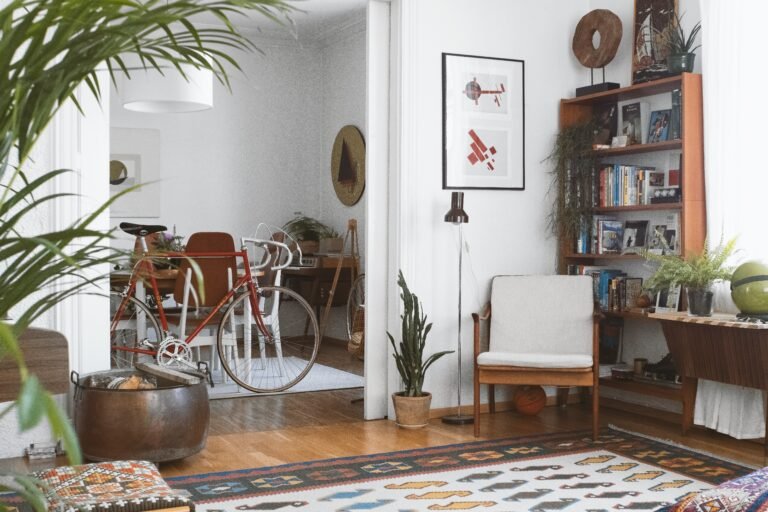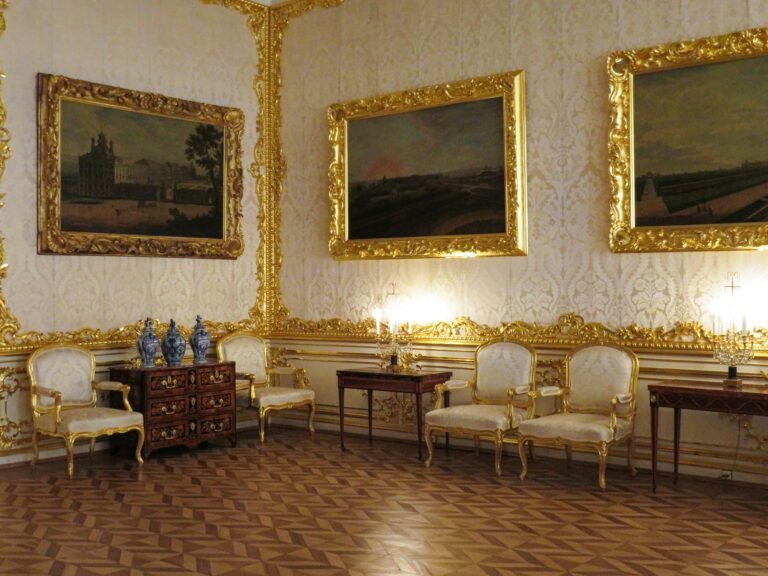Art Deco, short for Arts Décoratifs, emerged in the 1920s as a celebration of modernity, luxury, and innovation. Characterized by bold geometric patterns, rich colors, and opulent materials, this design style encapsulated the glamour and exuberance of the Roaring Twenties. Today, Art Deco is experiencing a resurgence, seamlessly blending with contemporary aesthetics to create interiors that are both sophisticated and timeless. This guide explores how to incorporate Art Deco elements into modern interiors, paying homage to its historical roots while adapting to present-day design sensibilities.
The Essence of Art Deco Style
Art Deco is distinguished by its emphasis on symmetry, streamlined forms, and luxurious materials. Originating in France and gaining international prominence between the World Wars, it reflects a period of economic prosperity and technological advancement. The style often features geometric patterns, such as chevrons and zigzags, and incorporates materials like chrome, glass, and exotic woods to convey elegance and opulence.
Key Elements of Art Deco Interior Design
Geometric Patterns and Bold Lines
Geometric motifs are central to Art Deco design, manifesting in furniture silhouettes, textiles, and architectural details. Incorporating patterns like chevrons, zigzags, and sunbursts can add visual interest and a sense of movement to a space. These elements can be introduced through wallpaper, flooring, or decorative accents.
Luxurious Materials
The use of sumptuous materials is a hallmark of Art Deco interiors. Incorporating elements such as marble, lacquer, chrome, and exotic woods can evoke the style’s signature opulence. For instance, a coffee table with a marble top or a mirror with a chrome frame can serve as focal points in a modern living room.
Rich Color Palettes
Art Deco color schemes often feature deep jewel tones like emerald green, sapphire blue, and ruby red, complemented by metallic accents in gold, silver, and chrome. These colors can be balanced with neutral shades to prevent overwhelming the space. For example, pairing a navy blue velvet sofa with gold-accented cushions can create a harmonious blend of color and texture.
Statement Lighting
Lighting in Art Deco design is both functional and decorative, often featuring bold geometric shapes and luxurious materials. Chandeliers with cascading crystals or sconces with chrome finishes can add a touch of glamour to modern interiors. Positioning these fixtures strategically enhances their impact and contributes to the overall ambiance.
Furniture Selection
Choosing furniture that reflects Art Deco’s streamlined silhouettes and geometric forms is essential. Look for pieces with curved edges, inlaid wood, or mirrored surfaces. A sideboard with a glossy lacquer finish or a bed frame with a sunburst motif can serve as statement pieces that anchor the room’s design.
Decorative Accents
Accessories play a crucial role in infusing Art Deco elements into contemporary spaces. Incorporate mirrors with geometric frames, metallic vases, and bold artwork featuring abstract or stylized figures. These accents can tie the room together and reinforce the desired aesthetic.
Textiles and Patterns
Introduce textiles that showcase Art Deco patterns, such as rugs with geometric designs or cushions adorned with stylized motifs. Velvet and silk are excellent fabric choices that add a layer of luxury and comfort. Ensure that these patterns and textures complement the overall color scheme to maintain cohesion.
Architectural Details
Incorporating architectural elements like archways, moldings, and paneling can enhance the Art Deco feel. If structural changes are not feasible, consider using wallpaper or decals that mimic these features. This approach allows for flexibility and can be tailored to suit various budgets and spaces.
Balancing Art Deco with Modern Minimalism
While Art Deco is known for its opulence, it can be harmoniously blended with modern minimalist design principles. Focus on incorporating select statement pieces rather than overwhelming the space with multiple bold elements. This balance ensures that the interior remains elegant and uncluttered.
Case Studies: Modern Interpretations of Art Deco
Contemporary Living Room
In a modern living room, an emerald green velvet sofa paired with a gold-framed glass coffee table embodies Art Deco elegance. A geometric patterned rug and a statement chandelier with chrome accents complete the look, creating a space that is both inviting and luxurious.
Chic Bedroom Retreat
A bedroom featuring a bed with a tufted headboard in deep blue, complemented by mirrored bedside tables and gold-accented lamps, captures the essence of Art Deco. Adding a sunburst mirror above the bed serves as a focal point, enhancing the room’s aesthetic appeal.
Practical Tips for Implementing Art Deco Design
- Start Small: Begin by incorporating Art Deco accessories like mirrors, lamps, or cushions before committing to larger pieces.
- Mix and Match: Combine Art Deco elements with contemporary furniture to create a balanced and personalized look.
- Focus on Quality: Invest in high-quality materials and craftsmanship to ensure longevity and authenticity in design.
- Consult Professionals: If unsure, seek advice from interior designers who specialize in Art Deco to guide you in achieving an authentic yet modern interpretation of the style. They can help you avoid over-designing while still making impactful style statements.
Art Deco Style in Different Rooms
Art Deco Living Room Ideas
The living room is the perfect canvas for Art Deco expression. It’s where bold design choices can shine without overwhelming functionality. Consider the following strategies:
- Furniture: Incorporate curved sofas in velvet upholstery, lacquered coffee tables, and sideboards with geometric inlays.
- Lighting: Opt for standout lighting fixtures like tiered chandeliers or globe-shaped sconces with brass or chrome finishes.
- Walls & Floors: Feature wallpaper with Art Deco motifs like fan shapes, stylized florals, or repetitive geometrics. A monochrome or metallic patterned area rug can tie everything together.
Art Deco Kitchen and Dining Areas
Art Deco kitchens and dining spaces can combine modern appliances and efficiency with vintage charm.
- Cabinetry: High-gloss lacquered cabinetry in black, navy, or deep green with gold hardware immediately evokes a Deco feel.
- Lighting & Backsplash: A geometric backsplash in marble or metallic tile and pendant lighting in brass or frosted glass delivers subtle sophistication.
- Furniture: Dining tables with sleek lines and rich materials—such as a glass top with gold legs—paired with upholstered chairs complete the ambiance.
Art Deco Bathroom Design
Bathrooms are an often-overlooked space where Art Deco can thrive. Clean lines and luxurious finishes make this a great area to channel 1920s glamour.
- Fixtures: Think pedestal sinks, clawfoot tubs, and chrome or matte black faucets.
- Tiling: Use bold, black-and-white checkerboard flooring or a geometric tile pattern to add that signature Art Deco flair.
- Mirrors & Lighting: Install mirrors with scalloped edges or sunburst designs and light sconces with frosted glass globes for an opulent touch.
Art Deco vs. Other Vintage Styles
It’s easy to confuse Art Deco with other early 20th-century styles like Art Nouveau or Mid-Century Modern. Here’s how they differ:
| Style | Time Period | Characteristics |
| Art Deco | 1920s–1940s | Bold geometry, luxurious materials, symmetry |
| Art Nouveau | 1890s–1910s | Flowing lines, nature-inspired motifs, organic forms |
| Mid-Century Modern | 1945–1969 | Clean lines, functional form, minimalist materials |
Knowing the differences helps you stay true to the design philosophy you want to adopt.
Sustainable Art Deco: A Modern Twist
Incorporating Art Deco into modern interiors doesn’t mean sacrificing sustainability. With eco-conscious design on the rise, there are creative ways to honor this style responsibly:
- Vintage & Antique Pieces: Source authentic Art Deco furniture or lighting from thrift stores or antique dealers. Not only is this sustainable, but it also brings unmatched character.
- Eco-Friendly Materials: Choose recycled glass, responsibly sourced wood, and low-VOC paints for your Art Deco palette.
- LED Lighting: Swap out incandescent bulbs in your vintage light fixtures for energy-efficient LEDs to maintain the glamour without the energy waste.
Common Mistakes to Avoid
Art Deco is a bold style, but balance is key. Here are pitfalls to sidestep:
- Overcrowding with Patterns: Too many geometric patterns can create visual chaos. Limit bold patterns to a few statement areas.
- Inconsistent Themes: Mixing too many eras or clashing color palettes can disrupt the visual harmony. Stick to Art Deco principles for cohesion.
- Ignoring Scale: Oversized furniture or accessories can overwhelm smaller rooms. Always measure your space and plan proportions accordingly.
- Neglecting Functionality: Aesthetic should never outweigh function. Ensure each Art Deco element serves a purpose in your everyday life.
Final Thoughts: Bringing 1920s Glamour into the 21st Century
Incorporating Art Deco into modern interiors is about celebrating the past while embracing the present. The style’s timeless appeal lies in its ability to merge bold glamour with clean, sophisticated lines—making it surprisingly adaptable to today’s homes.
Whether you’re redecorating a single room or embarking on a whole-home transformation, Art Deco offers a rich, expressive palette of textures, patterns, and materials to play with. By blending vintage elegance with contemporary sensibilities, you can create interiors that are both uniquely personal and classically stylish.
Alex is the creator of Homely Haven, a space dedicated to simple, stylish ideas for interiors and gardens alike. With a passion for cozy living rooms, inviting outdoor spaces, and practical DIY solutions, Alex shares tips and guides that help turn any house into a true home.
From budget-friendly decorating hacks to weekend garden projects, the goal is always the same: to inspire you to create spaces that feel personal, beautiful, and welcoming. When not writing, Alex is usually rearranging furniture, sketching new garden layouts, or exploring design trends for the next project.








